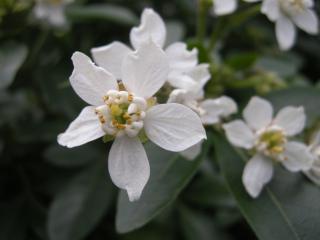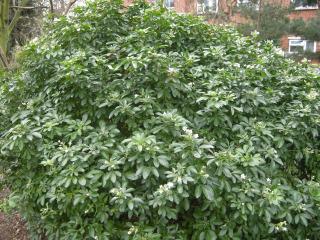
Choisya ternata flower (11//01/2012, London)
Position: Full Sun to Partial Shade
Flowering period: Late spring to early summer (I assume the specimen shown here is a result of our mild winter)
Soil: Well drained
Eventual Height: 3m
Eventual Spread: 2.5m
Hardiness: 7a – 9b
Family: Rutaceae
Choisya ternata is a bushy, rounded evergreen shrub with a dense appearance. The dark green leaves are opposite, glossy, leathery and palmately divided into fans of 3 to 13 leaflets. The individual leaves are up to 8cm long and release a pleasant fragrance when crushed. The star shaped hermaphrodite flowers are pure white with green stigma. They are scented and up to 3cm across . The fruit is a 2 to 6 sectioned leathery capsule.
Choisya ternata, commonly known as Mexican Orange or Mock Orange is native to southwestern United States and most of Mexico. It was introduced from Mexico into the UK in 1825. The genus was named after Jacques Denis Choisy (1799 – 1859) who was a Swiss botanist and Philosopher in Geneva.
The etymological root of the binomial name Choisya is derived from the surname of Jacques Choisy as mentioned above. Ternata is derived from the Latin ternum ‘three each’, referring to the leaves often appearing in threes.

Choisya ternata (11//01/2012, London)
The landscape architect may find Choisya ternata useful as an effective, evergreen, medium sized ground cover plant with fragrant flowers, particularly in light shade locations. It is effective when planted en mass due to its low maintenance. It may be planted as both a formal and informal hedge. It is drought and pollution tolerant once established.
Ecologically C. ternata’s flowers attract the Honey bee and butterflies.
The Royal Horticultural Society has given C. ternata their prestigious Award of Garden Merit in 1993.
C. ternata prefers moist, fertile, well-drained soils. It will tolerate most pH of soil.
C. ternata requires little maintenance. To encourage a second flush of flowers in autumn cut the stems by 25cm after flowering in spring.
Advertisement
